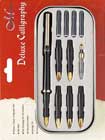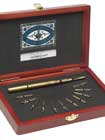
It is practiced in the world, but it occupies a very important place in Asia. To achieve calligraphic works, it is important to have the following three items: ink,brush and paper specially provided for this purpose.In calligraphy, there are mainly two types of ink: the Indian ink and the special calligraphy ink.
The Indian ink is the most commonly used because it gives very good results and is easy to use for people who are new to the world of calligraphy. In addition to being practical and efficient, the ink has an excellent reputation because it is a material that has a very strong story. Some people give it special properties and raise it to the rank of mysterious and powerful product.
Contrary to what many people think, the ink is not permanent and density can easily be arranged to suit all type of designs.
A dense ink is preferable to make lines or lettering but it is best to dilute it with a little water for the work of filling and construction of wash. There are also specially made inks for calligraphy as water-based inks, the Gallo-Ferric inks, thick inks and also substitution inks such as extract Cassel ink, watercolor and gouache. Some inks will tend to change color over time, so the Gallo-Ferric for example.
The brush is the basic tool for making calligraphy. The models differ in size, thickness, composition and form. The brush is more difficult to handle than the pen for a beginner. However, it allows for a large number of effects thanks to its special texture. Do not be surprised when buying your first calligraphy brush because the bristles are often glued together or secured in a thin layer of resin to facilitate transport and storage. Before first use, it is necessary to soak it in water to release the hair. To ensure a good life, it is important to take care of calligraphy brushes. At the end of each session, gently clean the brushes with water making sure to remove any ink. After that, dry the brush in a paper towel.
Then comes the paper for calligraphy. Traditionally, the Chinese paper called "rice paper" is used. To start, it is advisable to use a watercolor paper or ink, which provide good ink absorption. For a more accurate rendering and closest result of traditional calligraphy, some prefer to use a traditional vellum or parchment. In general, it is best to choose a paper with a high enough weight to avoid that the ink does flatten or pierce the paper.





